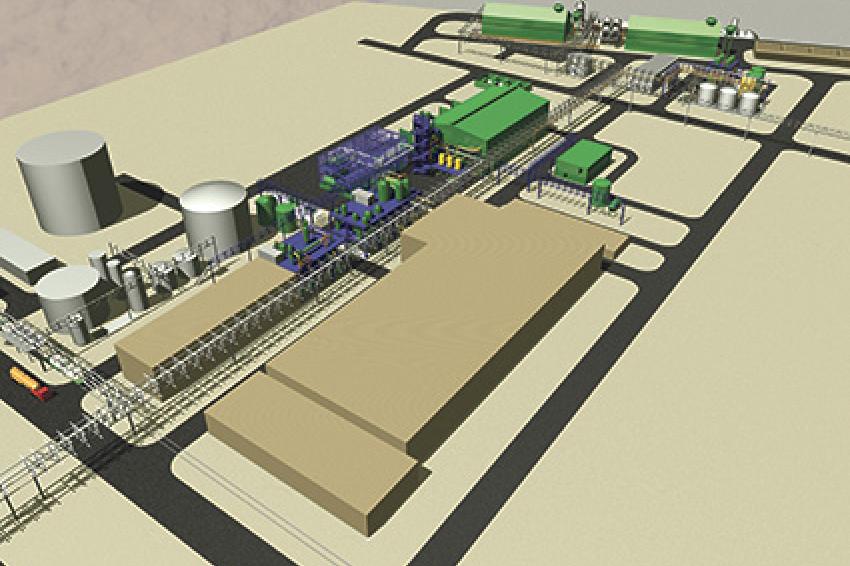Chlor-Alkali Strives to Stay Competitive
High Energy Prices Threaten European Industry as Imports from Low-Cost Producers Rise
For Europe's chlor-alkali industry, reduction of its rising production costs, especially energy costs, is now a pressing priority. This is not only because of the sector's low margins but also because of the need to stem an alarming decline in its share of its own domestic market to imports, particularly from North America. Ironically the biggest cuts in the European industry's total energy consumption could stem from another major challenge - the necessity in the next three to four years to close all of its remaining mercury capacity. A switch from the mercury process, amounting at present to 18% of Western European capacity, to membrane technology could result in considerable savings in individual plants, in which energy can account for as much as 60% of total production costs.
Need for Cost Reduction
The issue of costs at a time of rising energy prices, tighter environmental regulations and intensifying competitive global markets for chlor-alkali products like caustic soda was the main theme of the recent technology conference in Madrid of Euro Chlor, Europe's trade association for chlor-alkali producers. Andrew Brown, director of the inorganics group of the consultancy IHS, warned the conference that the European chlor-alkali industry had been falling behind its major competitors, particularly North America, since the 1990s. In the last four years the trend has accelerated.
The margins on an electrochemical unit (ECU), a measurement of chlor-alkali output, were about equal between the two regions in the late 1990s. But over the last few years the average ECU margins were around $200 lower in Europe, Brown said. The US had more chlorine production capacity - 13.7 million tons a year against 11.1 million tons in Western Europe - but a third fewer players at 24 compared with 36. The average capacity per player in the US was 600,000 tons a year against 300,000 tons in Western Europe. In 2013 the average cash margin for each chlorine producer in the US was $230 per ECU while in Western Europe it was $36, Brown said.
Because of the shale gas boom in the US, a wide gap had opened up between North American energy prices and those in Europe, which was affecting the international competitiveness of European chlor-alkali products. Natural gas prices in the US are now over half those in Europe. Alistair Steel, Euro Chlor's executive director, told the meeting that electricity cost per ECU now varies between 45% and 60% of full cash costs. In the European Union, governments are permitted to provide financial compensation to chlor-alkali producers and other energy-intensive sectors for high energy costs. "But not all member states pay this," he said.
For chlor-alkali producers replacing mercury with membrane-based capacity, the energy savings could be as high as 30% while at the same time the operation and maintenance of the converted plant would be easier, Dolf van Wijk, Euro Chlor science and regulatory affairs director, told the meeting. Euro Chlor had made a voluntary commitment to phase out mercury capacity by 2020. However, the European Commission effectively overruled this, when under the 2010 Industrial Emissions Directive (IED) tighter rules were introduced on best available technology (BAT) criteria. This meant that by the end of 2017, mercury chlor-alkali plants would no longer be given permits to operate. Currently the 18% of Western Europe's chlor-alkali capacity based on the mercury process is by far the largest share in the worldwide industry. In other regions, the largest share at 9% is Africa and the Middle East followed by the Americas with 5% and Asia at 1%, said Brown of IHS.
AkzoNobel in May opened an electrolysis plant in Frankfurt, which replaced one based on the mercury process. It expects energy consumption to be reduced by 30% and its overall ecological footprint by 20%. Companies like AkzoNobel have taken the opportunity when switching from mercury to membrane technology to introduce other cost-saving innovations in the converted plants. AkzoNobel has introduced a vacuum process at the Frankfurt unit for decreasing the amounts of impurities, such as sulphate, calcium and magnesium, in the plant's salt raw material. The new process reduces capital costs by a minimum 30%, compared with the conventional use of rock salt, and salt purification costs by at least 90% mainly because less equipment and maintenance is required. "It helps save energy by preventing the formation of iron deposits in the electrolysis cell," said Anna Giatti, AkzoNobel's market development manager for salt.
Process Conversion
The total savings through conversion of mercury to membrane processes, now accounting for around two-thirds of European chlor-alkali capacity, depends on how much of the old plant is retained. With a large proportion of conversions, the brine system and existing cell rooms are being reused, said Christophe Noeres, deputy chief executive of ThyssenKrupp Electrolysis. As the European sector moves to more advanced technologies, one option was the installation of radical new systems such as the oxygen depolarized cathode (ODC) technology, developed jointly by ThyssenKrupp and Bayer MaterialScience (BMS). In a demonstration plant at Krefeld-Uerdingen, Germany, it consumed 30% less energy than conventional processes. The ODC technology adds oxygen to the electrolysis process, which suppresses the formation of hydrogen so that the only products are chlorine and caustic soda.
Robert Kelly, international business development manager at AFC Energy, a UK-based fuel cell technology company, pointed out the opportunities for adding value to the hydrogen output of conventional chlor-alkali plants. Fuel cells, using excess hydrogen from chlor-alkali units, can, for example, provide electricity to power the plants. Under a project with Dow Chemical and Air Products, AFC fuel cell technology is due to be installed at a Dow chlor-alkali facility at Stade, Germany, by the end of this year. The scheme will help "deliver the concept of economically viable fuel cells for the chlor-alkali industry," Kelly predicted.
Upgrading membranes in chlor-alkali plants is another means of cutting costs. Yuji Sekiguchi of Asahi Kasei Chemicals of Japan, pioneers in ion exchange membranes, listed at the conference a range of membrane-surface enhancements by his company, including coatings with higher tolerance of impurities, more efficient and stable polymers, and reinforcements to cope with lower voltages with higher current efficiencies.
As a long-established center for the development of electrolysis technologies, Europe also has the task of keeping ahead of innovators in the emerging economies. "Our vision is to become a global leader in energy-saving electrolysis," said Sian Wang of Bluestar Chemical Machinery Co., Beijing, which has now been supplying ion-exchange membrane electrolyzers for over 30 years and is one of the world's biggest chlor-alkali electrolyzer producers. Its present R&D program includes the development of technologies in chromic salt and sulphate electrolysis and circulating water micro-electrolysis. One objective is the use of oxygen cathode electrodes to reduce the average electrolysis cell voltage of around 3V to 2V, Wang said.
Market Adjustment
In addition to making its chlor-alkali production technologies more cost-effective, the European sector needs to consolidate so that a pie chart of European chlor-alkali capacity does not show producers "packed in like sardines," said Brown of IHS. Currently, Ineos, Solvay, Dow, AkzoNobel and BMS account for around 60% of Western European capacity with the remaining 30 players composing the rest. The planned creation of a chlor-alkali joint venture by Ineos and Solvay, which was approved by the European Commission in May, was a step in the right direction. The venture will make up around a quarter of Western European chlor-alkali capacity and about half that for vinyl.
With a number of likely plant closures, some of them mercury facilities whose owners will shut them down rather than invest in conversions, Western European chlorine capacity could drop from 11 million tons a year to 9-10 million tons a year, raising average operating rates from just above 80% to just above 90% by 2018. At the same time, however, there could be a rise in imports, especially of caustic soda, from North America and the Middle East, where producers will have the advantage of low energy costs. "Europe will change from being traditionally a net exporter of chlor-alkali products to a net importer," Brown said. "Imports could rise from around 300,000 tons a year to around 600,000 tons by 2018, with the highest proportion, of about 40%, coming from North America.
Nonetheless with the anticipated steep rise in operating rates, Western European chlor-alkali players will have the satisfaction of enjoying much healthier margins, which will put them in a stronger position to invest further to compete against increasing imports.
Contact
Chemical Market Reporter
32 Queenborough Lane
Braintree,Ess. CM7 8QE
United Kingdom
+44 1376 331051
+44 1376 322752







